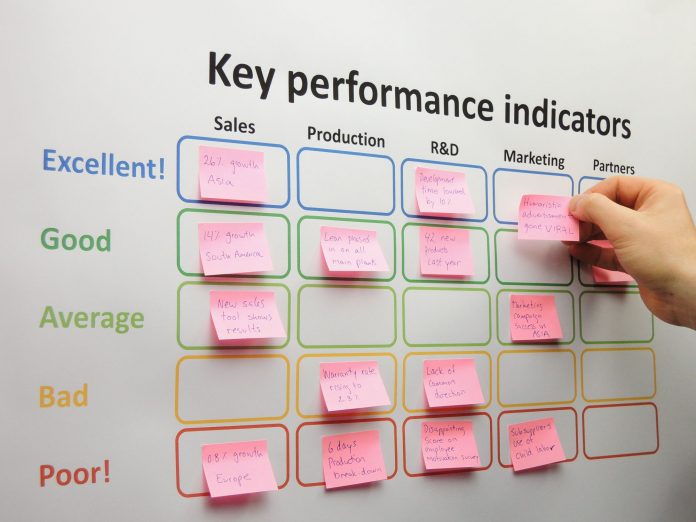As a startup owner, it’s essential to track specific metrics to take your organization to a new level. Unfortunately, a prevalent mistake some entrepreneurs make, especially after launching their venture, is focusing solely on revenue and profits.
Don’t get it wrong. Yes, keeping track of your startup’s revenues and profits can play a critical role in the success of your venture. What we mean is collecting, measuring, and analyzing a vast pool of the right metrics guarantee the survival and maturation of your startup.
Moreover, successful entrepreneurs rely on the correct data in lieu of gut and instincts to grow their business. On the other hand, keeping track of too much data might overwhelm your startup’s operation and set it to a failing path. That’s where KPIs come in place.
Key Performance Indicators (KPIs) are measurable values that highlight a company’s performance and how effectively it’s achieving its objectives. Of course, KPIs vary depending on the industry of your startup.
Nonetheless, there are some core metrics that every startup must measure to understand the performance and health of its operations. Consequently, it will be more viable for startup owners to make essential adjustments in their execution to attain strategic goals and, ultimately, optimal success.
This masterpiece elucidates the key performance indicators every startup must measure. As a result, setting goals, measuring progress, keeping your team motivated, and even gaining the attention of angel investors will be more feasible.
Is your startup measuring these top 5 KPIs?
If your startup isn’t tracking the following KPIs, you might as well be setting it up for failure.
Customer Acquisition Cost (CAC)
Allegedly, the customer acquisition cost is the most vital KPI for every startup and SME. As the name gives it away, CAC measures how much a firm spends to acquire new clients. It constitutes the funds spent on marketing, advertisement costs, the total cost of sales to gain a customer, and the property or assets used to persuade an individual to purchase a product/service.
Customer Acquisition Cost = Total sales and marketing expenses / Number of customers acquired.
A lower CAC is an effective strategy to bolster your startup’s profitability and the likelihood of success. Still, it would be best if you didn’t prioritize lowering your startup’s CAC at the expense of the quality of your marketing.
Therefore, for optimal results, only cut unnecessary CAC expenses. In addition, a low CAC may not be ideal if you have low retention rates. All in all, the general rule of thumb for a viable business is for the cost of acquiring new customers to be ⅓ or less of your customers’ lifetime value.
Besides helping your startup generate more profit, this metric enables you to establish which marketing technique effectively brings in more customers. Also, investors rely on the CAC metric to analyze the scalability and viability of a startup.
Customer Lifetime Value
Customer Lifetime Value, also initialed as CLV, CLTV, LCV, and LTV, is a metric to track how valuable a customer is to your organization. It’s also a critical statistic to track and keep the customer experience program in check. What’s more, CLTV can help you create retargeting and retention strategies.
Considering it’s much cheaper to keep existing customers than acquire new clients, having a high value of your existing customers is ideal for driving growth. There are several possible ways to calculate your startup’s CLV.
Nonetheless, the most elementary way is to multiply the annual revenue per customer by their lifespan and subtract the initial cost of acquiring them. That is:
CLV = (Annual revenue per customer * client relationship in years) – CAC
CLV metric will go a long way in helping your startup forecast cash flows and the number of customers it needs to achieve profitability. Also, investors use the metric to figure out what every customer is worth to a company in financial terms.
In sum, measuring your startup’s CLV goes a long way in ensuring you develop proper strategies to acquire new clients and retain existing ones while maintaining profit margins. As such, CAC and CLV complement each other. As we have outlined, CAC is essential. Still, it doesn’t tell the whole story. Customer Lifetime Value will ultimately help you sustainably run a profitable business.
Monthly Recurring Revenue (MRR)
As the name gives it away, Monthly Recurring Revenue is the amount of revenue your startup generates every month. Keeping track of MRR helps make precise sales projections and plan for short-term and long-term business growth. In addition, measuring your startup’s monthly financial performance makes it possible to predict the next month’s revenue. Consequently, you can make appropriate changes in your sales effort to increase revenue.
Calculating MRR is pretty simple. First, multiply the Average Revenue Per User by the total number of active users in a month. We have briefly explained ARPU later in the post.
MRR = ARPU * total number of monthly users
MRR is among the most vital financial metrics since it helps you keep your startup’s financial health in check.
Customer Churn Rate
Unfortunately, businesses of all sizes will lose customers in their quest for success. Customer churn rate or attrition rate is a KPI that shows the percentage at which customers stop transacting with an organization. Therefore, customer churn rate helps determine if your clients are happy and satisfied with your startup.
A low churn rate implies that customers are satisfied with your startup’s operations. On the other hand, a high churn rate could suggest your startup isn’t solving problems for its target audience. This might adversely affect profits and impede growth.
In sum, customer churn rate pinpoints concern with your customer management processes, product/service issues, and pricing models.
Here is the formula for measuring your startup’s customer churn rate.
(Customers lost within 30 days / Total customers at the start of a time period)n * 100
Staff productivity
Employee productivity is a KPI that shows how efficient your startup team members are for a task or project. It might appear to be a straightforward measurement, but the factors that influence it are varied and complex.
It’s essential to track the productivity of your startup’s employees to understand its performance. As a result, you can make informed decisions when delegating tasks and using resources to complete a project. Keep in mind, an under-utilized staff is a liability to your startup’s operations. Project management tools are effective in keeping track of your staff’s productivity.
Other KPIs to consider for the growth of your startup
As already outlined, your startup can track and measure a myriad of KPIs to keep track of its progress. This post just pinpoints and explains in detail the top 5 KPIs you ought to keep in check to ensure your growing venture keeps its doors open.
Other KPIs you ought to be knowledgeable about include:
- Average Revenue Per User (ARPU) establishes the total revenue you generate from all your active users. ARPU helps calculate vital KPIs such as the MMR. It can also be used to gain better insights into your target buyer personas and improve your pricing.
- Monthly Active Users
- Revenue Growth Rate
- Gross Profit Margin
- Viral Coefficient metric











![5 Unrealistic New Year Resolutions [Idy On Fire]](https://investitin.com/wp-content/uploads/2019/01/588-Arctcle-100x70.jpg)
